As the days grow shorter and the nights cooler, cozying up around a fire pit becomes increasingly enticing. And what better way to enjoy the warmth and ambiance than under the shelter of a gazebo? But, can you put a fire pit under a gazebo safely? This question has undoubtedly crossed the minds of many homeowners seeking to create the perfect outdoor retreat.
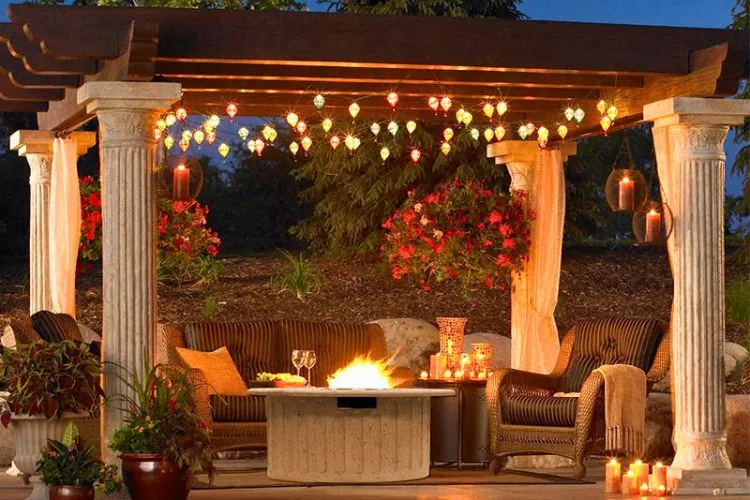
Here I will look into the concerns surrounding fire pits and gazebos, exploring the safety precautions and measures to consider before combining these popular backyard features. We’ll also discuss the types of fire pits and gazebo materials best suited for this setup. So, grab a cup of hot cocoa and embark on this journey to ensure your dream outdoor oasis remains safe and enjoyable for all.
Can you put a fire pit under a gazebo?
Putting a fire pit directly under a gazebo is not recommended due to the potential fire hazard it poses. The heat generated by the fire pit can cause the gazebo to catch fire, especially if the gazebo is made of flammable materials such as wood or fabric.
Additionally, the smoke and fumes from the fire can accumulate under the gazebo, which can harm your health. If you want to use a fire pit in your outdoor living space, it is best to place it at a safe distance from the gazebo and ensure that it is on a fire-resistant surface.
You can also consider using a fire pit specifically designed for use under a gazebo or other covered structure, which will have additional safety features to prevent fires and smoke buildup.
How much clearance do you need for a fire pit?
The clearance required for a fire pit depends on various factors such as the type of fire pit, the fuel source, and the location. Generally, it is recommended to have a minimum clearance of 10-20 feet around the fire pit to ensure safety and prevent any potential hazards.
If you are using a wood-burning fire pit, it is important to ensure no overhanging branches or nearby flammable materials such as dry leaves or grass. The fire pit should be placed on a non-combustible surface such as concrete or brick and not directly on a wooden deck or any other flammable surface.
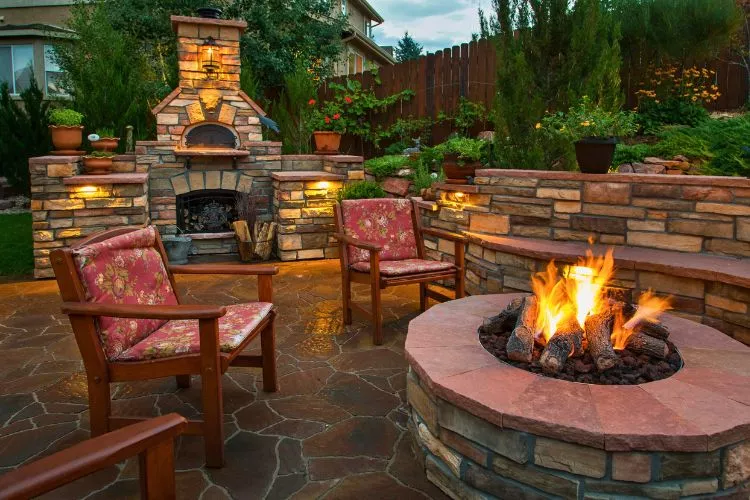
If you use a gas fire pit, the clearance requirements may vary depending on the manufacturer’s instructions. It is important to follow the manufacturer’s guidelines and ensure that the fire pit is installed safely away from any flammable materials.
In addition to the clearance requirements, it is also important to have a fire extinguisher or a bucket of water nearby in an emergency. It is also recommended to check with your local fire department for any specific regulations or guidelines regarding fire pits in your area.
Overall, it is important to prioritize safety when using a fire pit and ensure that you have the appropriate clearance and safety measures.
How much height do you need above a fire pit?
The height needed above a fire pit depends on the type of fire pit, fuel source, and any overhead structures or coverings. Generally, it is recommended to have at least 7 feet of clearance above a fire pit to ensure proper ventilation and prevent heat damage or fire hazards.
If you are using a wood-burning fire pit, it is crucial to ensure no overhanging branches, combustible materials, or structures within the 7 feet clearance above the fire pit. This is to prevent the risk of fire hazards and to allow for proper smoke dissipation.
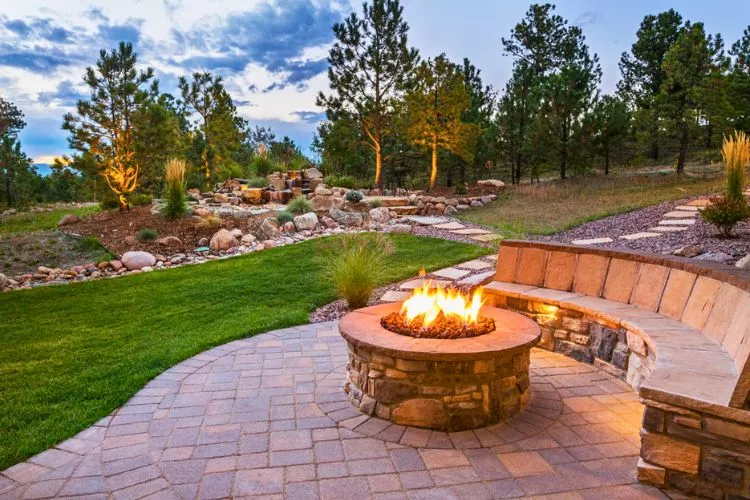
The height clearance for gas fire pits may vary depending on the manufacturer’s instructions. It is essential to follow the manufacturer’s guidelines and ensure the fire pit is installed safely with adequate height clearance.
Suppose you consider placing a fire pit under a covered structure such as a pergola or gazebo. In that case, it is important to ensure that the structure is made of non-combustible materials and has a sufficient height clearance above the fire pit. Using a spark screen or a fire pit with a chimney can also help direct the smoke and heat away from the overhead structure.
Remember to check with your local fire department or building codes for specific regulations or guidelines regarding fire pit height clearance in your area.
How much space do you need for a fire pit and seating?
When planning for a fire pit and seating area, there are a few factors to consider to determine the appropriate amount of space needed. The size of the fire pit and the desired seating arrangement are important considerations. Additionally, local regulations and safety guidelines should be taken into account. Here’s a detailed answer to help you determine the space requirements for a fire pit and seating:
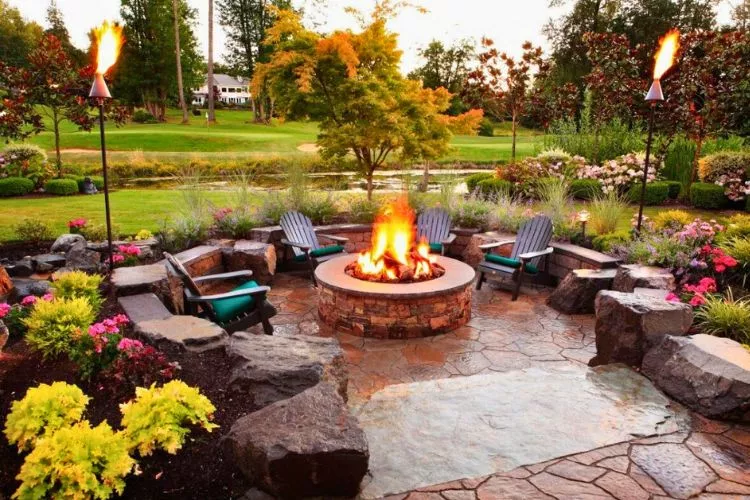
Fire Pit Size
The size of the fire pit can vary depending on personal preference and the available space. A typical fire pit ranges from 3 to 5 feet in diameter, although larger fire pits can be designed for bigger gatherings. The size of the fire pit will impact the amount of space needed around it for safety and comfort.
Seating Arrangement
The seating arrangement depends on how you plan to use the fire pit area. Do you envision cozy seating for a small group or larger seating for entertaining a larger crowd? The type of seating you choose, such as benches, chairs, or built-in seating, will also affect the space requirements. Consider the number of seats you want and leave enough room for people to move comfortably around the fire pit.
Safety Considerations
It’s crucial to prioritize safety when determining the space requirements for a fire pit. The area around the fire pit should be clear of any flammable materials, including plants, structures, or overhanging branches. Check your local fire codes and regulations to ensure compliance and to determine the minimum required distances for fire safety. This information may vary depending on your location, so it’s important to consult the relevant authorities.
Comfort and Accessibility
To create a comfortable and enjoyable space, consider the accessibility and convenience for your guests. Leave enough space for people to move freely and comfortably between the seating and the fire pit. Adequate clearance is essential to avoid accidental contact with the fire or hot surfaces. Providing extra space around the seating area can also accommodate additional furniture or activities you might want to include, such as side tables, outdoor lighting, or outdoor games.
Personal Preferences
Ultimately, the space needed for a fire pit and seating area will also depend on your preferences and the ambiance you wish to create. Some prefer a more intimate setting with cozy seating close to the fire pit, while others may opt for a larger, open area for socializing and entertaining. Take your desired atmosphere into account when determining the space requirements.
Is it safe to use a fire pit under a gazebo?
Using a fire pit under a gazebo can be a great way to enjoy the outdoors while staying warm and cozy. However, there are several factors to consider before doing so to ensure safety. These factors include ventilation, height, flammable materials, and local regulations.
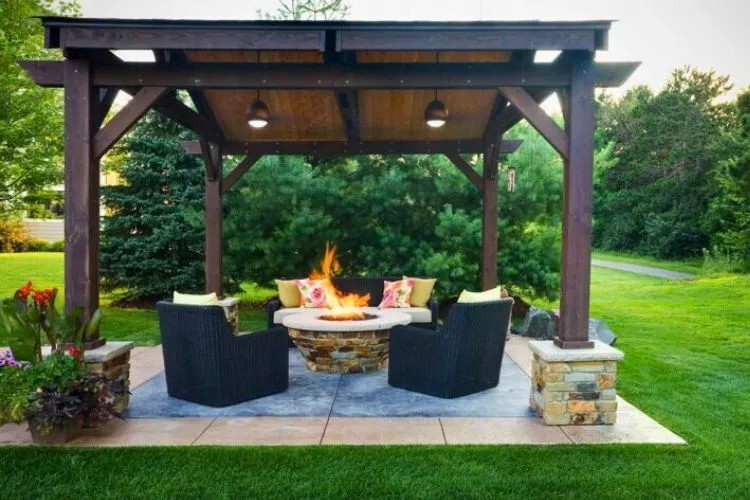
Ventilation
Proper ventilation is crucial when using a fire pit under a gazebo. Burning wood or other fuel produces carbon monoxide, a dangerous gas that can be lethal if inhaled in large quantities. To minimize the risk, make sure the gazebo has open sides or adequate vents to allow the carbon monoxide to escape, and fresh air to enter. Also, good ventilation can help prevent the accumulation of smoke, which can cause respiratory issues or discomfort.
Height
The height of the gazebo’s ceiling is another important factor to consider. Ideally, the fire pit should be placed under a gazebo with a high ceiling to minimize the risk of heat damage and fire. A general rule of thumb is to have a minimum of 7 feet clearance between the fire pit and the gazebo’s ceiling. This allows the heat to dissipate and reduces the chance of any materials catching fire.
Flammable Materials
A gazebo made of flammable materials, such as wood or fabric, poses a higher risk when using a fire pit underneath it. To minimize the fire risk, choose a fire pit with a spark screen and use a fire-resistant mat under the fire pit to protect the gazebo’s floor. Additionally, consider using fire-resistant materials for the gazebo’s construction or treating the materials with a fire retardant.
Local Regulations
Before setting up a fire pit under a gazebo, it’s essential to check local regulations and guidelines. Some areas may have specific rules regarding outdoor fires or require a permit for certain fire pits. Additionally, some regions may have temporary burn bans due to weather conditions or air quality concerns. Always adhere to local regulations to ensure a fire pit’s safe and legal use under a gazebo.
Other Firepit Related Articles: What to Put Under Fire Pit? | Can You Burn Drywall in a Fire Pit?
Frequently Asked Questions (FAQs)
Q: Can you put a small fire pit under a gazebo?
Yes, you can put a small fire pit under a gazebo, but ensure proper ventilation, sufficient height clearance, use of non-flammable materials, and adherence to local regulations for safety.
Q: Can I put a fire pit under a covered patio?
It is possible to put a fire pit under a covered patio, but you must consider proper ventilation, clearance from combustible materials, and local regulations to ensure safety.
Q: Where should you not put a fire pit?
You should not put a fire pit near flammable materials, under low-hanging branches, on wooden decks without proper protection, or in an enclosed space without adequate ventilation.
Q: Does a fire pit need a bottom?
Yes, a fire pit should have a bottom to contain the fire and ashes, protect the surface underneath, and provide stability. Using a fire-resistant mat or pavers can further protect the surface.
Q: What surface can I put a fire pit on?
You can put a fire pit on surfaces such as concrete, stone, brick, or gravel. Avoid placing a fire pit directly on grass, wooden decks, or other combustible surfaces without proper protection.
Conclusion:
In conclusion, placing a fire pit under a gazebo is possible and can enhance your outdoor experience. However, it’s essential to prioritise safety by ensuring proper ventilation, sufficient height clearance, the use of non-flammable materials, and compliance with local regulations. By taking these precautions, you can enjoy the warmth and ambiance of a fire pit under a gazebo while minimising potential risks.


